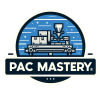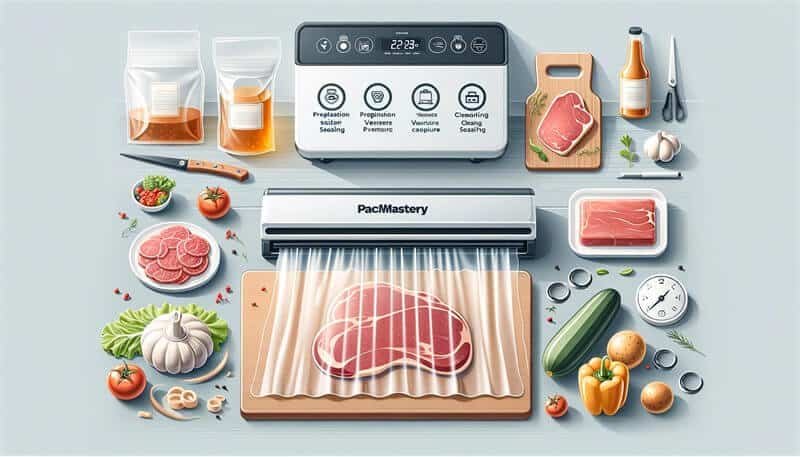Key Takeaways
| Question | Answer |
|---|---|
| What is vacuum packing? | A method of preserving food by removing air from the packaging to extend shelf life and maintain freshness. |
| How to use a vacuum packing machine? | Follow a step-by-step guide to prepare food, fill the bags, seal, store, and clean the machine after use. |
| What are the advantages of vacuum sealing? | Extends shelf life, preserves food quality, maximizes storage space, and reduces the need for chemical preservatives. |
| What are the disadvantages of vacuum sealing? | Initial cost, managing external gases, and potential difficulty in opening vacuum-sealed bags. |
| What safety measures should be followed? | Ensure proper hygiene, manage bacterial risks, and comply with food safety regulations. |
| Expert tips for vacuum sealing different foods? | Wrap sharp items, freeze liquids before sealing, and use accessories like bone guards and filler plates. |
Introduction
At PacMastery, our mission is to revolutionize the packing machinery industry through innovative solutions, unparalleled quality, and relentless dedication to customer satisfaction. We strive to empower businesses around the globe with cutting-edge technology and customized machinery, ensuring efficiency, reliability, and excellence in every packaging process. Committed to sustainability and ethical practices, we are not just building machines; we’re crafting a more efficient, productive, and responsible future in packaging.
Vacuum packing is an essential method for preserving food by removing air from the packaging, which helps extend the shelf life and maintain the freshness of the contents. This guide will walk you through the step-by-step process of using a vacuum packing machine, discuss the advantages and disadvantages, and provide expert tips to ensure you get the best results.
Step-by-Step Guide to Using a Vacuum Packing Machine
Step 1: Preparation
Proper preparation is crucial for effective vacuum sealing. Here’s how to get your food ready:
- Meats: Trim any excess fat and cut the meat into smaller portions. This ensures they fit well in the vacuum bags and are easier to store.
- Liquids: To avoid mess and potential damage to your machine, freeze liquids before sealing them. This method prevents spills during the vacuum process.
- Sharp Items: Wrap foods with sharp edges, like bones or uncooked pasta, in a soft material such as a paper towel. This prevents the sharp edges from puncturing the vacuum bag.
Step 2: Filling the Bag
When filling vacuum bags, ensure you leave enough space at the top for sealing. Typically, leaving three to five inches between the food and the top of the bag ensures a proper seal. This extra space allows you to reseal the bag if the first attempt isn’t successful.
Step 3: Sealing Process
The sealing process can vary slightly depending on the type of vacuum sealer you are using. Here’s a general guide:
- Automatic Sealers: Place the open end of the bag on the sealing strip, close the lid, and start the machine. Most automatic sealers will run until all the air is removed and the bag is sealed.
- Manual Sealers: These require you to manually set the vacuum cycle and sealing time. Follow the machine’s instructions for the best results.
- Handheld Sealers: Ensure the device is charged, lay the bag flat, and press the handheld sealer onto the bag. Hold the sealing button until all the air is removed.
Step 4: Storing Sealed Food
Vacuum-sealed foods should be stored appropriately to maximize their shelf life. Here are some tips:
- Freezer: Store vacuum-sealed meats, fish, and other perishables in the freezer. Properly sealed foods can last up to two to three years.
- Refrigerator: Use vacuum sealing to keep cheeses, deli meats, and vegetables fresh for extended periods.
- Pantry: Dry goods like grains, nuts, and dried fruits can be vacuum-sealed and stored in the pantry to prolong their shelf life.
Step 5: Cleaning and Maintenance
Maintaining your vacuum sealer is essential for hygiene and machine longevity. After each use:
- Wipe down the sealing strip and drip tray with a damp cloth.
- Clean the opening of the vacuum chamber.
- Wipe the exterior of the machine.
- Ensure the machine is completely dry before storing it.
Advantages and Disadvantages of Vacuum Sealing
Advantages
Vacuum sealing offers numerous benefits, making it a preferred method for food preservation:
- Extends Shelf Life: Vacuum-sealed foods last significantly longer than those stored using traditional methods.
- Preserves Food Quality: It prevents freezer burn, dehydration, and maintains the food's flavor and texture.
- Maximizes Storage Space: Removing air reduces the volume of stored items, allowing for more efficient use of space.
- Reduces the Need for Chemical Preservatives: Vacuum sealing is a natural way to preserve food without additional chemicals.
Disadvantages
Despite its advantages, vacuum sealing has some drawbacks:
- Initial Cost: The cost of the vacuum sealer and accessories can be a significant initial investment.
- Managing External Gases: For modified atmosphere packaging (MAP), managing the necessary gases can be complex and costly.
- Difficulty in Opening Bags: Vacuum-sealed bags can be challenging to open, especially if thick plastics are used.
For more information on how PacMastery's advanced vacuum packing machines can elevate your food preservation process, visit our Comprehensive Guide to Vacuum Packaging Machines.
Safety and Compliance in Vacuum Packing
Food Safety Risks
When using a vacuum packing machine, understanding and managing food safety risks is crucial to ensure the safety of the packaged food. Some common food safety risks include:
- Clostridium Botulinum: This bacterium can grow in low-oxygen environments, such as vacuum-sealed packages, and produce toxins that cause botulism. It can thrive at chilled temperatures of +3°C, making it essential to maintain proper storage conditions.
- Listeria Monocytogenes: Found in many foods, this bacterium can grow at low temperatures and in vacuum-packed foods. It is particularly dangerous in ready-to-eat foods.
- Yersinia Enterocolitica: Commonly found in contaminated water and food, it can grow at temperatures as low as -1°C, posing a risk in vacuum-packed foods.
- Bacillus Cereus: Often associated with rice, dairy products, and vegetables, this bacterium can produce toxins in vacuum-packed foods at low temperatures of +4°C.
To mitigate these risks, it's essential to follow proper hygiene practices, ensure correct storage temperatures, and separate vacuum packing machines for raw and ready-to-eat foods. Implementing a comprehensive food safety management system based on HACCP principles is also crucial.
Legal Requirements
Complying with food safety regulations is essential for businesses using vacuum packing machines. This includes conducting regular risk assessments, implementing controls to prevent contamination, and adhering to government guidelines. For more details on food safety regulations and risk assessment templates, visit our Advanced Food Vacuum Packing Machines.
Expert Tips and Best Practices
Specialized Tips for Different Foods
Different types of foods require specific techniques for optimal vacuum sealing. Here are some expert tips:
- Meats: Ensure meats are properly trimmed and portioned before sealing. This helps in achieving a better seal and easier storage.
- Liquids: Freeze liquids before vacuum sealing to prevent spills and ensure the integrity of the seal.
- Sharp Items: Wrap items with sharp edges in a soft material, such as a paper towel, to prevent puncturing the vacuum bag.
Use of Accessories
Using the right accessories can enhance the efficiency and effectiveness of your vacuum packing process:
- Bone Guards: Protect vacuum bags from being punctured by sharp bones.
- Filler Plates: Reduce vacuum time by occupying space in the vacuum chamber, which also prolongs the life of the machine.
- Custom-Sized Vacuum Bags: Cut bags to your desired length for efficient use and optimal sealing.
Cooking and Reheating Vacuum-Sealed Foods
Vacuum sealing is not just for storage; it also simplifies cooking and reheating. Here are some methods:
- Sous Vide Cooking: This method involves cooking vacuum-sealed food in a water bath at a precise temperature, ensuring even cooking and enhanced flavor retention.
- Boiling: Vacuum-sealed foods can be boiled directly in the bag, preserving nutrients and flavor.
- Microwaving: Some vacuum-sealed foods can be microwaved, but ensure the bags are microwave-safe to avoid melting or bursting.
For more expert advice and advanced features of our vacuum packing machines, visit our Advanced Meat Packing Solutions.
Conclusion
Vacuum packing machines are invaluable tools for preserving food quality and extending shelf life. By following proper preparation, sealing, and storage techniques, as well as adhering to food safety guidelines, businesses can maximize the benefits of vacuum sealing. At PacMastery, we are committed to providing innovative and reliable packaging solutions to meet your needs. Explore our range of innovative packaging solutions to enhance your business operations.
For more information on our comprehensive range of packaging machines and solutions, visit PacMastery. If you have any questions or need further assistance, please contact us.




One Response
Great blog here! Also your webgsite loads up very fast!
What web host are you using? Can I get your affiliate link
to your host? I wish my web site loaded up as fast as yours
lol http://boyarka-inform.com/